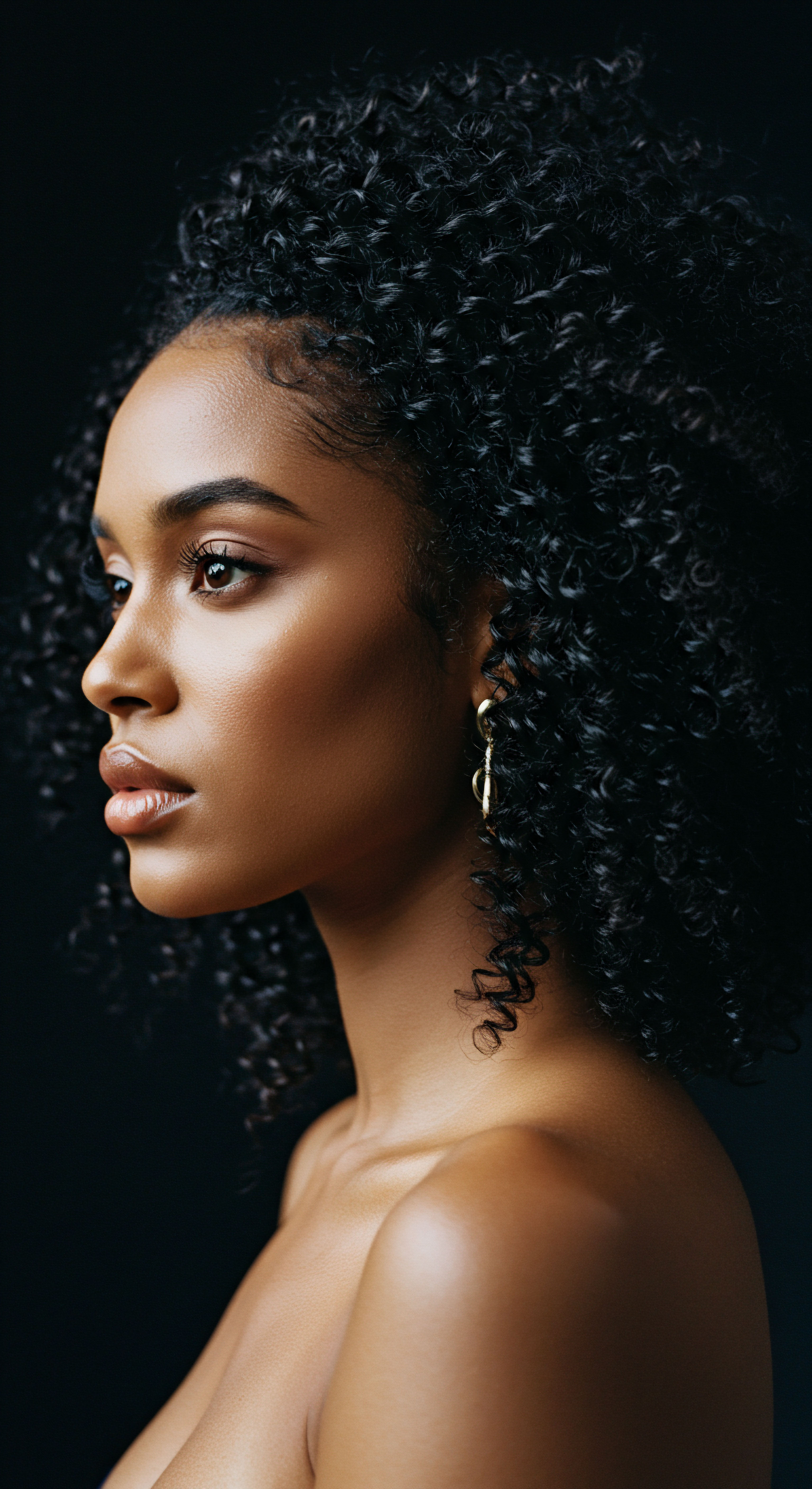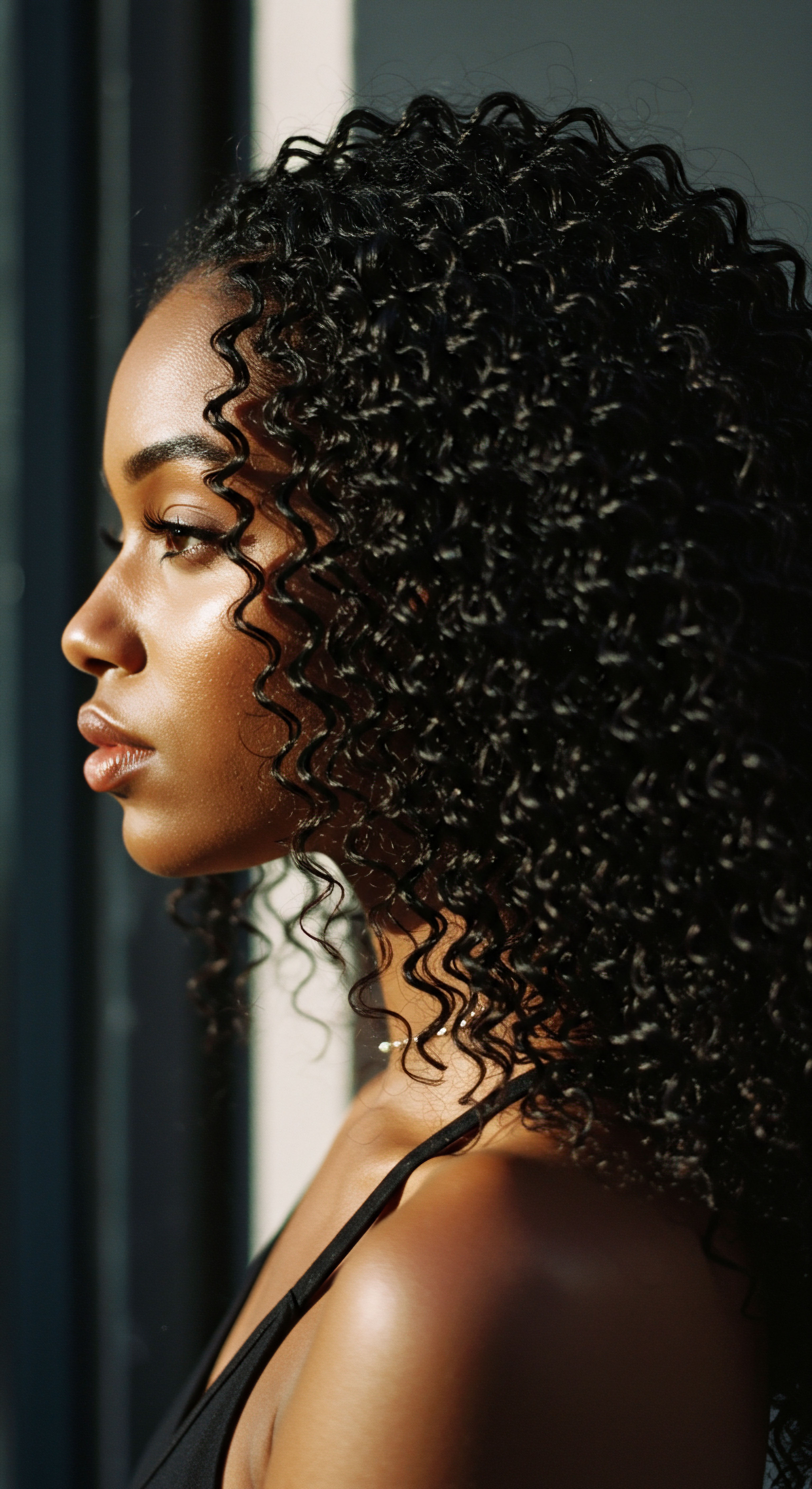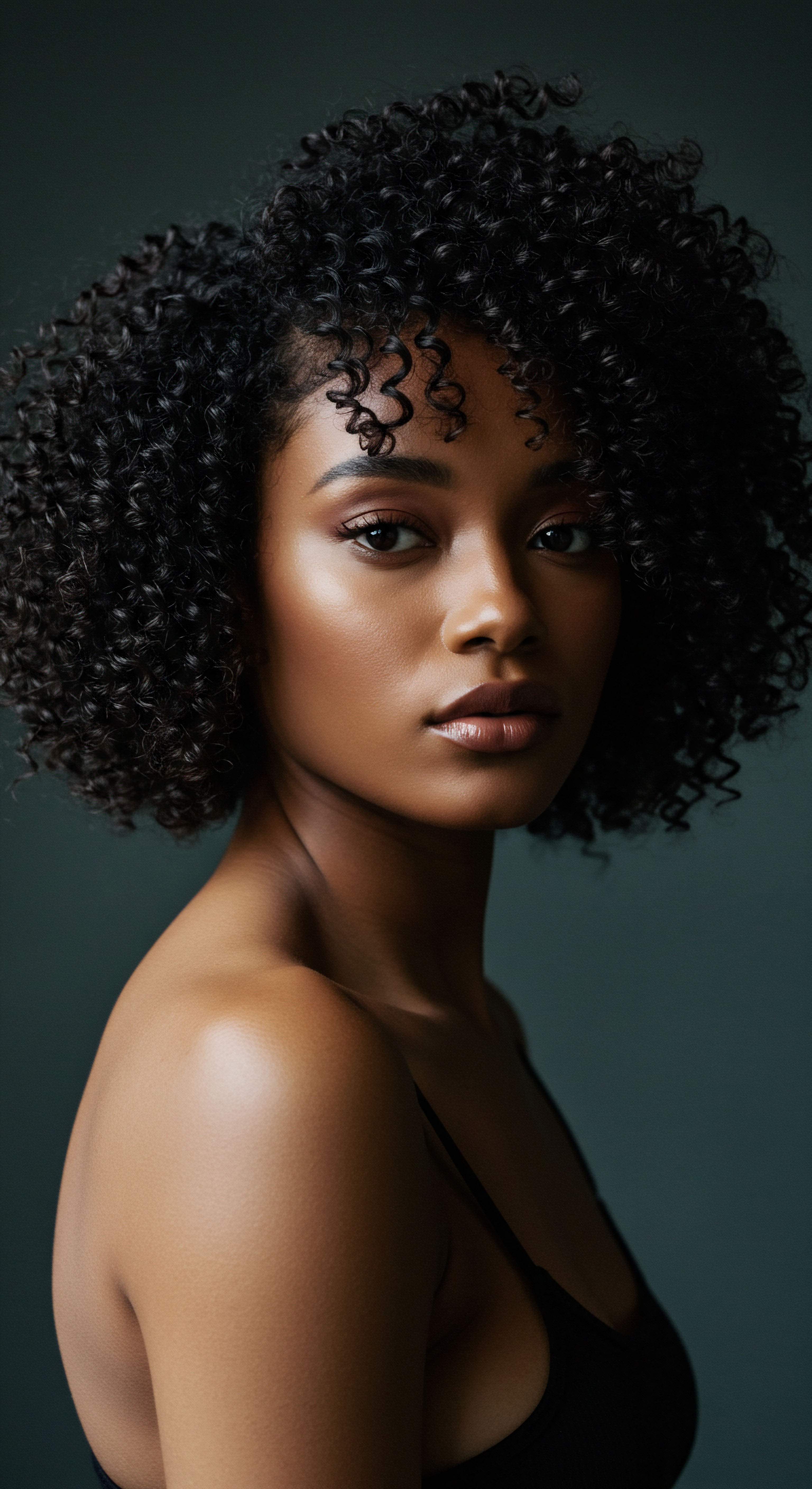
Roots
The whisper of night, a time when the world slows its breath, holds a quiet significance for those with textured hair. As dusk descends, our strands, in their exquisite coil and curl, embark upon their own nocturnal journey. We often consider the daytime elements—sun, wind, styling—yet the hours of slumber, when our hair rests against a surface, carry an unspoken weight.
It is a period of vulnerability, a delicate exchange between strand and fabric, shaping the health and appearance that greets the dawn. This exploration begins at the very essence of this interaction, delving into the foundational elements that dictate whether our hair emerges revitalized or burdened by the night’s quiet friction.

The Architecture of Textured Strands
To truly appreciate the needs of textured hair at night, one must first comprehend its unique architectural marvel. Unlike straight hair, which typically possesses a circular cross-section, textured hair, whether wavy, curly, coily, or kinky, often exhibits an elliptical or even flattened shape. This structural variation is not merely aesthetic; it dictates how moisture is distributed along the hair shaft and how easily strands interlock and abrade.
The cuticle, the outermost protective layer composed of overlapping scales, tends to be more raised in textured hair. This raised cuticle, while offering some resilience, also means greater surface area for potential snagging and moisture loss, especially when encountering less sympathetic materials.
Consider the intricate dance of the disulfide bonds and hydrogen bonds within the hair’s cortex, responsible for its distinctive shape. These bonds, influenced by moisture and heat, are the very scaffolding of the curl pattern. During sleep, as the hair shifts against a pillow, these bonds can be temporarily disrupted or even compromised, leading to a loss of definition and increased susceptibility to damage. Understanding this microscopic reality guides our choices for nighttime protection.

The Language of Hair Types
The spectrum of textured hair is vast and beautiful, often categorized to help individuals identify their specific needs. While classifications like the Andre Walker Hair Typing System (1A-4C) offer a common reference, it is vital to remember that individual strands can exhibit variations within a single head. A strand might be 3C at the root and 4A at the ends, influenced by growth, manipulation, and environmental factors.
- Type 2 hair ranges from loose waves to defined S-shapes, often with a finer texture that can be prone to frizz and flatness if not properly supported at night.
- Type 3 encompasses true curls, from loose spirals to tight corkscrews. These curls are often more susceptible to tangling and losing their pattern overnight due to friction.
- Type 4 hair, from tight coils to Z-patterns, possesses the most pronounced bends and turns, making it the most vulnerable to shrinkage, dryness, and breakage from abrasive surfaces. Its natural inclination to intertwine means even minimal friction can create knots and snags.
Each hair type, with its inherent characteristics, responds differently to the surfaces it encounters. A fabric that might suffice for a looser wave could prove detrimental to a tighter coil, accelerating moisture depletion and mechanical stress. This personalized understanding is the first step toward serene slumber for your strands.
The intrinsic architecture of textured hair, from its elliptical cross-section to its raised cuticles, renders it uniquely susceptible to friction and moisture loss during sleep.

Moisture Dynamics and Nocturnal Loss
Moisture is the lifeblood of textured hair. Its coiled structure makes it more challenging for natural oils (sebum) produced by the scalp to travel down the entire length of the hair shaft, leaving the ends particularly vulnerable to dryness. This inherent dryness is exacerbated by environmental factors and, crucially, by the surfaces our hair encounters.
During sleep, conventional pillowcases, often made of cotton, act as silent moisture thieves. Cotton, a highly absorbent material, draws moisture not only from the skin but also from the hair. This phenomenon is a significant contributor to the common morning woes of dryness, frizz, and diminished curl definition.
The porous nature of cotton fibers creates a rough terrain for delicate strands, increasing friction and, consequently, mechanical damage. This relentless drawing of moisture is a primary reason why fabric choice for nighttime hair protection becomes a critical consideration.
The continuous rubbing against an absorbent surface can lead to a phenomenon known as Hygral Fatigue, where the hair shaft repeatedly swells and contracts as it gains and loses moisture. This cycle weakens the hair’s internal structure over time, making it more brittle and prone to breakage.

Ritual
As the day yields to evening, a quiet anticipation often settles upon us, a moment to transition from the demands of the waking world to the restorative embrace of sleep. For those tending to textured hair, this transition extends to a deliberate, gentle preparation of our strands for the night. The choice of fabric for nighttime protection is not merely a practical decision; it is a thoughtful ritual, a conscious act of care that shields our hair from the unseen challenges of slumber. This section guides us through the practical wisdom and considered choices that shape a protective nighttime experience, moving beyond mere habit to a practice grounded in understanding.

The Silk Standard
When considering the ideal fabric for textured hair at night, Silk consistently emerges as the leading contender. Its superiority stems from its unique protein structure and smooth, tightly woven fibers. Unlike cotton, silk is a natural protein fiber, similar in composition to human hair itself. This inherent similarity contributes to its gentle interaction with the hair shaft.
The surface of silk is remarkably smooth, offering minimal friction. As textured hair glides across a silk pillowcase or within a silk bonnet, the likelihood of snagging, tangling, and breakage is significantly reduced. This reduction in mechanical stress is paramount for preserving curl patterns and minimizing frizz.
Furthermore, silk is far less absorbent than cotton. It allows the hair to retain its natural oils and applied moisture treatments, rather than drawing them away. This characteristic is vital for textured hair, which, as discussed, is inherently prone to dryness.
A study published in the Journal of Cosmetic Science, though primarily focused on skin, notes silk’s low absorbency compared to cotton, a principle directly applicable to hair’s moisture retention. This property means your hair stays hydrated throughout the night, leading to softer, more pliable strands in the morning.
Silk, a natural protein fiber, provides an exceptionally smooth, low-friction surface that allows textured hair to retain its vital moisture and reduce mechanical damage during sleep.

Satin Alternatives
While silk reigns supreme, Satin offers a commendable and often more accessible alternative. It is important to distinguish that satin is a weave, not a fiber. Satin fabrics can be made from various fibers, including polyester, nylon, or rayon. When selecting satin for hair protection, the key lies in the weave’s smoothness.
A high-quality polyester satin, with its slick surface, can mimic many of silk’s benefits regarding friction reduction. It allows hair to slide rather than snag, thereby helping to preserve curl definition and minimize tangles. While synthetic satin may not offer the same breathability or temperature regulation as natural silk, its smoothness is a significant advantage over cotton. For those seeking a more budget-friendly option, satin pillowcases or bonnets are a widely recommended choice for effective nighttime hair protection.
When choosing satin, look for a tight weave and a soft, supple feel. The goal is to maximize the slickness of the surface to minimize hair friction.

Why Cotton Falls Short for Textured Hair at Night
Despite its widespread use and perceived comfort, cotton is generally not the optimal choice for textured hair at night. Its fibers, though soft to the touch, possess a microscopic roughness and high absorbency that actively work against the health of textured strands.
- Moisture Depletion ❉ Cotton acts like a sponge, drawing moisture from your hair. This leads to dryness, a primary concern for textured hair types.
- Increased Friction ❉ The rougher surface of cotton fibers creates significant friction as hair moves against it. This friction causes the cuticle scales to lift, leading to frizz, tangles, and ultimately, breakage.
- Disturbed Curl Pattern ❉ The constant rubbing against cotton can disrupt the natural curl pattern, leading to flattened, undefined, or stretched-out curls by morning.
Switching from a cotton pillowcase to one made of silk or satin is often one of the simplest yet most impactful changes one can make in a textured hair care regimen.

What Specific Nighttime Accessories Aid Hair Health?
Beyond pillowcases, various accessories provide targeted protection for textured hair during sleep.
- Bonnets ❉ A well-fitting silk or satin bonnet provides an enclosed, protective environment for the hair. It keeps strands contained, preventing them from rubbing against the pillow or getting tangled throughout the night. Look for bonnets with an elastic band that is comfortable but secure enough to stay on.
- Scarves ❉ Large silk or satin scarves offer versatility, allowing for various wrapping techniques that can preserve specific styles, like braids, twists, or roller sets. They also offer excellent coverage for longer hair.
- Pillowcases ❉ For those who find bonnets or scarves uncomfortable, a silk or satin pillowcase is a fundamental step. It ensures that even if hair escapes a wrap, it still rests on a gentle surface.
The choice between these often depends on personal preference, hair length, and the desired level of protection. Many individuals use a combination, perhaps a bonnet for daily wear and a silk pillowcase as a backup.

Relay
Moving beyond the foundational principles and daily practices, we arrive at a deeper inquiry into the nuanced interplay between textiles, hair science, and the broader cultural landscape that shapes our understanding of textured hair care. The seemingly simple question of the best nighttime fabric unveils layers of historical context, scientific specificity, and even the psychology of self-care. This section seeks to connect these disparate elements, painting a comprehensive picture that transcends mere product recommendations, inviting a profound consideration of how our choices resonate with the enduring legacy of textured hair and its preservation.

A Historical Echo of Hair Preservation
The practice of covering hair at night, particularly for textured hair, carries a rich historical and cultural lineage. Across various African and diasporic traditions, head coverings were not merely decorative; they served as vital tools for hair preservation, hygiene, and social signaling. From the elaborate gele of West Africa to the headwraps worn by enslaved women in the Americas, these coverings protected delicate strands from environmental aggressors and, crucially, from the friction of rough sleeping surfaces. The contemporary use of silk and satin bonnets and scarves is, in many ways, a continuation of this ancestral wisdom, adapted with modern materials that offer superior glide and moisture retention.
This continuity speaks to an enduring understanding of textured hair’s vulnerability and the necessity of proactive protection. It is a testament to the ingenuity of communities who, through generations, developed practices to maintain hair health despite challenging circumstances. The fabric choice for nighttime care, therefore, is not a recent invention but a contemporary iteration of a long-held tradition.

The Micromechanics of Fiber and Hair
At a microscopic level, the interaction between hair and fabric is a complex dance of forces. The coefficient of friction, a measure of the resistance to motion of one surface over another, plays a critical role. Natural cotton fibers, when viewed under a microscope, appear as twisted, uneven ribbons.
This irregular surface creates numerous points of contact and snagging for the hair cuticle. In contrast, silk fibers are long, smooth, and cylindrical, presenting a much lower coefficient of friction.
When hair rubs against a high-friction surface like cotton, the delicate cuticle scales are lifted, abraded, and even chipped away. This damage exposes the inner cortex, leading to moisture loss, increased porosity, and a rougher texture that is more prone to tangles and frizz. Over time, this cumulative damage can manifest as split ends, breakage, and a general lack of luster.
Conversely, when hair glides over a low-friction surface like silk, the cuticle layers remain flat and intact. This preserves the hair’s natural smoothness, helps seal in moisture, and minimizes the mechanical stress that leads to damage. The impact is visible in the morning ❉ hair that is less tangled, more defined, and retains its softness.

How Does Hair Porosity Affect Nighttime Fabric Needs?
Hair porosity, which refers to the hair’s ability to absorb and retain moisture, is a significant factor in determining its nighttime needs.
- Low Porosity Hair ❉ This hair type has tightly bound cuticle layers, making it difficult for moisture to penetrate. Once moisture is in, however, it is retained well. For low porosity hair, the primary concern at night is preventing product buildup and ensuring moisture doesn’t simply sit on the surface. While silk is still beneficial for friction reduction, the emphasis might be more on ensuring the hair isn’t overly sealed in a way that prevents natural air circulation if heavy products are used.
- Normal Porosity Hair ❉ This hair type has cuticle layers that are neither too open nor too closed, allowing for a good balance of moisture absorption and retention. For normal porosity hair, silk or satin offers ideal protection, preserving its healthy state without excessive intervention.
- High Porosity Hair ❉ This hair type has raised or damaged cuticle layers, allowing moisture to enter and exit easily. High porosity hair is highly susceptible to moisture loss and damage from friction. For this hair type, the moisture-retaining and friction-reducing properties of silk are absolutely paramount. It acts as a critical barrier against the nocturnal moisture drain and mechanical stress that can further compromise its already vulnerable structure.
Understanding your hair’s porosity allows for a more tailored approach to nighttime care, reinforcing the choice of fabric that best supports its unique moisture dynamics.

Beyond the Fabric The Role of Environmental Humidity
While fabric choice is a powerful tool, it operates within a broader environmental context. The humidity levels in your sleeping environment also play a role in how your hair behaves overnight. In very dry climates, even with a silk pillowcase, some moisture loss can occur. Conversely, in highly humid environments, too much sealing with a bonnet might lead to excessive moisture or even fungal growth if not managed properly.
Consider the relative humidity within your sleeping space. For instance, a study on textile properties for bedding materials might highlight how certain fabrics interact with ambient moisture and body heat. While not directly on hair, the principles of moisture wicking and breathability apply.
Silk, being a natural fiber, offers better breathability than many synthetic satins, which can be an advantage in warmer or more humid climates, preventing the hair from becoming overly damp or suffocated. This nuanced understanding allows for a holistic approach to nighttime hair preservation, integrating fabric choice with environmental awareness.

Reflection
The journey through the subtle yet significant world of nighttime hair protection for textured strands reveals a truth far richer than a simple material recommendation. It underscores the profound connection between our daily rituals and the enduring health of our hair, a connection that bridges scientific understanding with cultural heritage. The choice of silk or satin is not merely about preventing frizz; it is an act of gentle preservation, a silent acknowledgment of the unique needs of our hair, and a continuation of wisdom passed through generations. As the moon casts its gentle glow, we find serenity in knowing our coils and curls are cradled in comfort, poised to greet the new day with vibrancy and grace.

References
- Kim, S. Y. & Cho, J. S. (2014). Effects of silk and cotton fabrics on skin hydration and transepidermal water loss. Journal of Cosmetic Science, 65(3), 187-195.
- Das, B. & Maity, S. (2018). Thermal comfort properties of knitted fabrics for bedding materials. Journal of Textile Science & Engineering, 8(1), 1-5.
- Franbourg, A. Hallegot, P. Baltenneck, F. Freyssinet, J. M. & Bouloc, A. (2003). The human hair ❉ From anatomy to physiology. Physiology and Pharmacology of the Skin, 2, 85-112.
- Robbins, C. R. (2012). Chemical and Physical Behavior of Human Hair (5th ed.). Springer.
- Khumalo, N. P. (2000). Hair breakage and hair loss in women of African descent. International Journal of Dermatology, 39(2), 85-91.